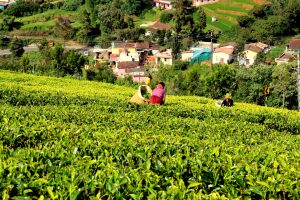While this is rather obvious thing to say, most Indians still live in rural areas. As per the 2011 census, such citizens comprised 68.84 percent of the total population. Even this number does not reflect the reality. Many city-dwellers remain in touch with parents and grandparents and branches of their extended family still living in the villages. Many inhabitants of the villages work in cities but their families remain in the countryside. Others are temporarily employed, working wherever there is a job to catch – which often means urban areas – while remaining rooted in their villages. The recent lockdown of India due to the pandemic allowed us to at least partially assess the scale of this, when millions of people were forced to travel hundreds of kilometers from the cities to their villages.
There are websites entirely devoted to following the life, woes, and hopes of the Indian rural population. Three of these portals allow us to have a glance at the plight of the villages and their migrant workers after the lockdown shut company gates and halted trains.
The first is Gaon Connection, a brainchild of Neelesh Mishra. Gaon, by the way, means a “village” in some Indian languages (including Hindi). The newspaper and news portal publishes both texts and video materials, in English and in Hindi, and the coverage extends from northern India to Bangladesh. The articles and recordings focus on various challenges and problems, such as environment issues, the life of tribal communities, violence and women, but also other subjects, such as art, also find their place. The platform has been created to share more knowledge with villagers (including about government policies), and to make the voices of rural India better heard and its problems better seen in the cities (also by training citizens from rural areas to become local journalists). Gaon Connection has, for instance, published a survey of “25,371 rural residents, including migrant workers” affected by the lockdown, a study that was later summarized in an article by Shivani Gupta. Among its shocking statistics, it revealed that under the lockdown 23 percent of respondents had to walk back to their villages, and 12 percent were beaten by the police along the way.
My recommendations of some of the other recent publications from Gaon Connection would include: Rafiqul Islam Montu’s text on Bangladesh’s Manta community, the members of which, not possessing any lands, are forced to live their entire life on boats, moving from place to place (“Their lives, like the boats they live on, float in uncertainty,” the author writes); Ranvijay Singh’s story of how farmers from the Unnao district were cheated, as a person posing as their leader sold their land behind their backs; Nidhi Jamwal’s video coverage of the amazing pattachitra artists from Odisha; Natasha Joshi’s commentary on how outdated textbooks and methods of teaching English add to problems that the children of poor families face while learning the language. The last is to be read and listened to together with P. Sainath’s short material on the Potato Song – on tribal children in a south Indian village in Kerala being taught to sing a “song in English in honour of the potato that they don’t eat, in a village where no English is spoken.” This material was made available on the PARI Network website and this is where I now turn to.
PARI Network was created by the above-mentioned author and journalist, P. Sainath, and its name stands for “People’s Archive of Rural India Network.” Its coverage is similar to that of Gaon Connection, although wider in terms of geography and subjects. True to its name, it also includes archival, historical materials, and the articles are often available in other Indian languages than Hindi, but also in English. Another feature is that it offers a collection of audio files, including a range of folk songs.
Apart from this, some of the recent texts I would personally recommend, include, for instance: Riya Behl’s article on the plight of Nepali men working in India as guards and stranded there due to the lockdown; Rahul Maganti’s coverage on the dire and spartan conditions in which laborers are forced to construct a new, grand capital for the state of Andhra Pradesh, the city of Amaravati; Purushottam Kapur’s story about Rajkishor Sunani, a tribal activist who is using traditional folk tunes and themes as basis to sing songs in defense of environment and in defiance of large companies and governments who want to exploit it; Audra Caroline Bass’ article on the honey hunters from the Nilgiri Hills whose many customs serve to protect nature; or P. Sainath’s piece on “one of the loneliest libraries,” established within in a tea shop in a village deep within the forests of Kerala.
Last but not least, Khabar Lahariya is a newspaper and website that is not only focused on rural areas but managed exclusively by women journalists. Its texts and video materials are available both in English and in Hindi (and some of its dialects), and its focus is on the region of Bundelkhand. Of its recent materials I would recommend: a sorrowful story on how the lockdown is “pushing young girls out of school and into early marriages”; a harrowing review of the migrant workers’ way back home; and Nikita Joseph’s text on an obscure ritual followed in one place of India, during which boys beat dolls earlier prepared by the girls.
As a form of post script, I would like to recommend a 2017 series of articles by Supriya Sharma, “A Village Votes.” While it was published in a mainstream medium (Scroll.in), not by any of the three above-mentioned websites, and although it covered a regional election held at that time, the reportage lets the reader understand the real connections between local politics and rural life.

































